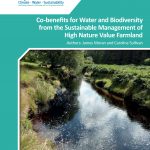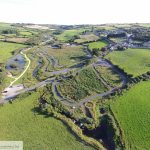Agriculture systems in Europe range from very intensive production on…
Biodiversity – the variety of life
The terms ‘nature’ and ‘biodiversity’ are interchangeable. Human beings are an intrinsic part of biodiversity and interact with it on a daily basis. Our activities change and shape the landscape in which we live and the consequent environmental and land use changes can have wide ranging influences on biodiversity.
What is Biodiversity?
The Convention on Biological Diversity (www.cbd. int) defines ‘biological diversity’ or biodiversity as the variability among living organisms from all sources including, among other things, terrestrial, marine and other aquatic ecosystems and the ecological complexes of which they are part; this includes diversity within species, between species and of ecosystems. The Oxford English Dictionary offers a simpler definition: ‘The variety of plant and animal life in the world or in a particular habitat, a high level of which is usually considered to be important and desirable.’ In short, biodiversity is the variety of life on earth. Biodiversity is under considerable threat however, both globally and in Ireland.
What are the key pressures?
The key pressures on Ireland’s habitats and species include direct habitat damage from peat cutting, wetland drainage/reclamation, over/ under-grazing, water pollution, unsustainable exploitation (e.g. overfishing), invasive alien species and recreational pressures. Climate change is also likely to have some effect on Irish species and habitats. Human population growth is an example of an indirect pressure, the effects of which are exacerbated by limited public awareness of the economic value of biodiversity and its benefits to society.
Protecting Biodiversity and Ecosystem Services
So why protect biodiversity? There is now an increased understanding that aside from the obvious environmental benefits of protecting biodiversity there are considerable economic benefits too. Biodiversity underpins our economy, health and well-being by providing us with clean air, water, food, materials, medicines and healthy functioning ecosystems amongst other things. This stock of ‘natural capital’ provides us with important ‘ecosystem services’. ‘The Economic and Social Aspects of Biodiversity – Benefits and Costs of Biodiversity in Ireland’, a study commissioned by the Dept. Environment, Heritage and Local Government in 2008, offered a preliminary and conservative estimate that biodiversity contributes at least €2.6 billion to the Irish economy annually through the goods and services it provides. It is, therefore, vital that we protect biodiversity, not only for the sake of protecting nature, but also for our own sustainability.
Ireland also has international and legal obligations to protect biodiversity and is committed under the Convention on Biological Diversity to halt biodiversity decline by 2020. Protection of biodiversity within and outside of protected areas is important and requires greater integration of biodiversity concerns in policy development and implementation at all levels. Ireland’s second National Biodiversity Plan (2011-2016) includes a programme of measures aimed at meeting Ireland’s biodiversity obligations. The plan outlines Ireland’s vision for biodiversity as follows: ‘That biodiversity and ecosystems in Ireland are conserved and restored, delivering benefits essential for all sectors of society and that Ireland contributes to efforts to halt the loss of biodiversity and the degradation of ecosystems in the EU and globally.’
Natura 2000 Network
Biodiversity is protected at a European level by the Habitats and Birds directives. These directives have resulted in the creation of a comprehensive network of sites for habitat and species protection called the Natura 2000 network. Details of Ireland’s protected sites can be found on the National Parks and Wildlife Service website (www.npws.ie/ protected-sites). The network consists of Special Areas of Conservation (SACs) as designated under the Habitats Directive and Special Protection Areas (SPAs) as designated under the Birds Directive. There are currently 430 SACs and 154 SPAs which are afforded legal protection in Ireland.
How are we doing?
Ireland supports a relatively low diversity of flora and fauna compared to mainland Europe. Nevertheless, our aquatic systems and wetlands support internationally significant populations of birds, fish and invertebrates. 41% of our habitats are currently assessed as being of bad conservation status, 50% are inadequate and 9% are favourable. The habitats of most pressing concern in Ireland are those that have reduced range and/or area, notably raised bogs and species rich grasslands.
Many of our species are reported as having a stable trend but a number of key or iconic species are declining. Current assessments of our species show that 52% are assessed as being of favourable conservation status, 20% inadequate, 12% bad and 16% are of unknown status. One of the species of greatest concern is the pollution sensitive freshwater pearl mussel as only a few healthy populations exist.
Over the last 40 years the breeding ranges of 47% of Ireland’s bird species have contracted, whereas 18% have expanded to new areas. Two groups of concern that have been highlighted are breeding waders and upland birds.
Red List Species – protecting species most at risk
Red Lists are assessments of species using the International Union for the Conservation of Nature (IUCN) categories and criteria. They identify species in most need of conservation interventions. The National Parks and Wildlife Service and Northern Ireland Environment Agency co-ordinate Ireland’s Red Lists (http://www.npws.ie/red-lists).
A new Red List for Irish macro-moths has recently been published, which categorises 43 species (8% of the Irish list) as being threatened to some degree (i.e., vulnerable, endangered or critically endangered).
Challenges
The current pressures on biodiversity need to be monitored and managed. There is a pressing need to build on current work and put in place robust baseline biodiversity monitoring systems and comprehensive ecosystem services mapping.
Land use changes and the planned intensification of agriculture may lead to further habitat loss if plans are not implemented in a sustainable way. The impacts of climate change and the continuing threat of invasive alien species are areas that also need to be constantly monitored and guarded against where possible.
Most importantly, on-going efforts to increase public awareness of biodiversity must be continued and augmented. Public awareness and appreciation of biodiversity and its intrinsic link to everyday life is vital if measures to protect our environment are to succeed.
Wayne Trodd, Ecological Monitoring and Assessment Unit, EPA and Ciara Maxwell, Inspector, Office of Environmental Enforcement, EPA
Read more
This subject is covered with in more detail in the 2016 EPA State of the Environment Report.
References
Bullock, C., Kretsch, C., & Candon, E. (2008). The Economic and Social Aspects of Biodiversity – Benefits and Costs of Biodiversity in Ireland. Dept. Environment, Heritage and Local Government.







